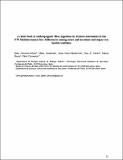Por favor, use este identificador para citar o enlazar a este item:
http://hdl.handle.net/10261/211442COMPARTIR / EXPORTAR:
 SHARE SHARE
 CORE
BASE CORE
BASE
|
|
| Visualizar otros formatos: MARC | Dublin Core | RDF | ORE | MODS | METS | DIDL | DATACITE | |

| Título: | A closer look at anthropogenic fiber ingestion in Aristeus antennatus in the NW Mediterranean Sea: Differences among years and locations and impact on health condition |
Autor: | Carreras-Colom, Ester; Constenla Matalobos, María; Soler-Membrives, Anna; Cartes, Joan Enric CSIC ORCID ; Baeza, Mireia; Carrasson, Maite | Palabras clave: | Fiber ingestion Aristeus antennatus Mediterranean Sea Plastic pollution Health condition |
Fecha de publicación: | ago-2020 | Editor: | Elsevier | Citación: | Environmental Pollution 263 Part A:114567 (2020) | Resumen: | Marine litter is one of the most concerning threats for marine wildlife especially regarding plastics and their micro-sized forms, widely known as microplastics. The present study evaluates mesoscale spatial (230 km, Catalan coast) and temporal (2007 vs 2017–2018, Barcelona area) differences on the ingestion of anthropogenic fibers in the deep-sea shrimp Aristeus antennatus in the NW Mediterranean Sea and its relation with shrimp’s health condition. Synthetic fibers with lengths ranging between 0.16 and 37.9 mm were found in both stomach (where sometimes they were tangled up in balls) and intestine contents. The percentage of fiber occurrence was >65% at each sampling point. Tangled balls of fibers observed in stomach contents exhibited a wide range of sizes (up to a diameter of 1 cm) and were usually composed of fibers of different polymers, sizes and colours. Differences between locations (2018) were found, with greater fiber loads towards the south during spring and a great variability in summer, as shrimps caught off Barcelona showed a nearly thirty-times higher fiber load compared to shrimps from other localities. Highest concentrations were more likely to be related to major sources of fibers and currents in the area. Fiber load in shrimps from 2007 was comparable to that of shrimps captured in 2017 and 2018 (spring) yet a shift in the proportion of acrylic and polyester polymers was detected. No consistent effect on shrimp’s health condition was found, with only a significant negative correlation found between gonadosomatic index and fibers for those shrimps with the highest values of fiber load (caught off Barcelona, summer 2018). Our findings contribute to the knowledge on plastic pollution for the NW Mediterranean Sea and highlight the potential use of this species as a sentinel species for plastic fiber contamination | Descripción: | 12 pages, 7 figures, 2 tables, 1 appendix | Versión del editor: | https://doi.org/10.1016/j.envpol.2020.114567 | URI: | http://hdl.handle.net/10261/211442 | DOI: | 10.1016/j.envpol.2020.114567 | Identificadores: | issn: 0269-7491 e-issn: 1873-6424 |
| Aparece en las colecciones: | (ICM) Artículos |
Ficheros en este ítem:
| Fichero | Descripción | Tamaño | Formato | |
|---|---|---|---|---|
| Carreras_Colom_et_al_2020_preprint.pdf | 2,43 MB | Adobe PDF |  Visualizar/Abrir | |
| Carreras_Colom_et_al_2020_suppl.pdf | 558,42 kB | Adobe PDF |  Visualizar/Abrir |
CORE Recommender
SCOPUSTM
Citations
28
checked on 21-abr-2024
WEB OF SCIENCETM
Citations
23
checked on 26-feb-2024
Page view(s)
211
checked on 23-abr-2024
Download(s)
632
checked on 23-abr-2024
Google ScholarTM
Check
Altmetric
Altmetric
NOTA: Los ítems de Digital.CSIC están protegidos por copyright, con todos los derechos reservados, a menos que se indique lo contrario.
